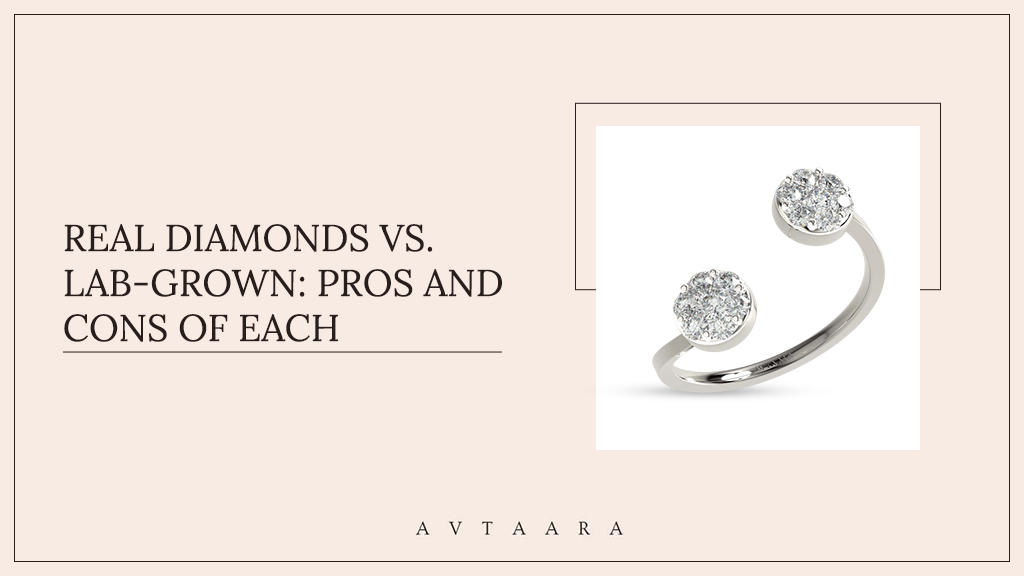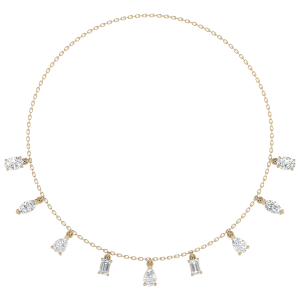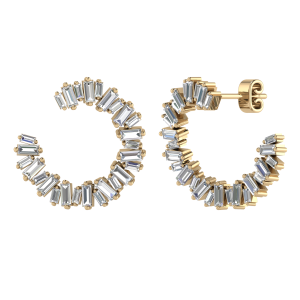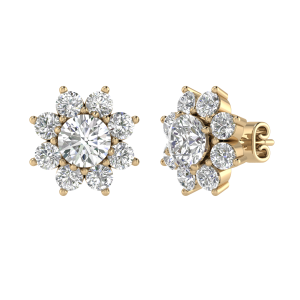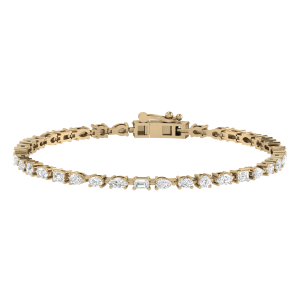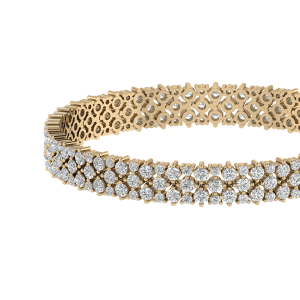In the world of diamonds, there are two main contenders: natural diamonds and lab-grown diamonds. Both have their own unique characteristics and advantages. Understanding the differences between the two can help you make an informed decision when it comes to purchasing these precious gems. Let’s dive deeper into the pros and cons of each.
Understanding the Origin of Natural Diamonds
Natural diamonds, also known as natural diamonds, are formed deep within the Earth over millions of years. This fascinating process begins with intense heat and pressure acting on carbon atoms, causing them to crystallize into diamonds. The formation of natural diamonds takes place in the Earth’s mantle, around 90 to 120 miles beneath the surface.
Deep within the Earth’s mantle, where temperatures can reach up to 2,200 degrees Fahrenheit, carbon-rich materials such as graphite or organic debris undergo a remarkable transformation. These materials, subjected to immense pressure, experience a metamorphosis that turns them into one of the most precious gemstones on the planet.
Over time, the carbon atoms within these materials bond together, forming a crystal lattice structure. This structure is what gives diamonds their unique properties, such as their exceptional hardness and refractive index. The process of crystallization occurs slowly, taking millions of years for diamonds to fully form.
The Formation Process of Natural Diamonds
The formation of natural diamonds begins when carbon-rich materials, such as graphite or organic debris, are subjected to the tremendous heat and pressure found deep within the Earth. As the carbon atoms bond together, they transform into the crystal structure that gives diamonds their exquisite beauty and strength.
The journey of carbon-rich materials from the Earth’s surface to the mantle is a remarkable one. It starts with tectonic plate movements, which cause subduction zones where one plate slides beneath another. These subduction zones act as conduits, carrying the carbon-rich materials to the depths of the Earth.
Once these materials reach the mantle, they encounter extreme conditions. The intense heat, generated by the Earth’s internal heat sources, causes the carbon atoms to become highly reactive. Under this heat, the carbon atoms rearrange themselves, forming the stable crystal structure of diamonds.
Simultaneously, the pressure in the mantle, exerted by the weight of the overlying rocks, further aids in the transformation of carbon into diamonds. The pressure is so immense that it can reach up to 725,000 pounds per square inch, equivalent to the weight of about 50 elephants on a postage stamp.
The Journey of Natural Diamonds: From Mines to Markets
Once formed, Natural diamonds are mined from the Earth’s crust through various methods. These methods include open-pit mining and underground mining. Open-pit mining involves removing the topsoil and extracting diamonds from large open pits. On the other hand, underground mining involves tunnelling into the Earth to reach diamond-rich deposits.
After extraction, rough diamonds undergo a meticulous process of sorting, cutting, and polishing to enhance their brilliance and shape. Skilled diamond cutters analyze each rough diamond to determine the best way to cut it, maximizing its beauty and value. The cutting process requires precision and expertise, as a single mistake can significantly affect the final outcome.
Once the diamonds are cut, they go through a rigorous grading process to evaluate their quality and characteristics. This process involves assessing the diamond’s colour, clarity, cut, and carat weight. Diamonds that meet the highest standards are then certified by reputable gemological laboratories, providing assurance to buyers of their authenticity and quality.
Finally, these exquisite gems are ready to be sold in jewellery stores around the world. From engagement rings to necklaces, diamonds have captivated human hearts for centuries. Their timeless beauty and rarity make them a symbol of love, prestige, and enduring elegance.
Unveiling the Science Behind Lab-Grown Diamonds
Lab-grown diamonds, also known as synthetic or cultivated diamonds, are created through advanced technological processes that mimic the natural formation of diamonds. The goal is to produce diamonds with the same chemical and physical properties as natural diamonds.
Lab-grown diamonds have revolutionized the diamond industry, offering an ethical and sustainable alternative to mined diamonds. These diamonds are not only environmentally friendly but also free from the ethical concerns associated with diamond mining, such as human rights abuses and environmental damage.
The Creation Process of Lab-Grown Diamonds
Lab-grown diamond is created in laboratory environments using two main processes: high-pressure, high-temperature (HPHT) and chemical vapor deposition (CVD). In the HPHT method, a small diamond seed is subjected to high temperatures and pressures, allowing carbon atoms to deposit on the seed and grow into a larger diamond. This process replicates the conditions found deep within the Earth’s mantle, where natural diamonds are formed over millions of years.
In the CVD method, a diamond seed is placed in a chamber filled with carbon-rich gas, causing carbon atoms to adhere to the seed and form a diamond. This process involves the use of cutting-edge technology and precise control of temperature and pressure to create diamonds layer by layer. The result is a diamond that is chemically identical to its natural counterpart.
The Technological Advances in Diamond Synthesis
Over the years, significant technological advances have been made in diamond synthesis, allowing for the production of high-quality lab-grown diamonds. These advancements have led to diamonds that are visually indistinguishable from natural diamonds, even to trained gemologists.
One of the key breakthroughs in diamond synthesis is the ability to control the diamond’s color. Natural diamonds come in a variety of colors, ranging from colourless to fancy colours like blue, pink, and yellow. Through advanced techniques, lab-grown diamonds can now be produced in a wide range of colours, offering consumers more options and flexibility.
Another important advancement is the improvement in diamond clarity. In the early days of lab-grown diamonds, they often had visible inclusions or flaws. However, with advancements in technology, lab-grown diamonds can now be produced with exceptional clarity, rivaling that of the finest natural diamonds.
Furthermore, the size of lab-grown diamonds has also seen significant improvements. Initially, lab-grown diamonds were limited in size, but with advancements in production techniques, larger diamonds can now be created. This has opened up new possibilities for jewelry designers and consumers who seek larger, more affordable diamonds.
In conclusion, lab-grown diamonds are a testament to human ingenuity and technological progress. Through advanced processes like HPHT and CVD, scientists and engineers have been able to create diamonds that are virtually identical to their natural counterparts. These diamonds offer a sustainable and ethical alternative to mined diamonds, while still possessing the beauty and brilliance that make diamonds so coveted.
The Advantages of Natural Diamonds
Natural diamonds have a timeless appeal and come with a set of unique advantages that make them highly desirable.
When it comes to the unique characteristics of natural diamonds, there is no denying their natural beauty and uniqueness. Each natural diamond is one-of-a-kind, with its own individual characteristics, including color, clarity, and cut. These characteristics are what give each diamond its distinct personality, making it a truly special gemstone.
Moreover, natural diamonds have a remarkable brilliance that is unmatched by any other gemstone. The way they reflect and refract light creates a dazzling display of sparkle and fire, captivating the eyes of anyone who beholds them. This exceptional optical property is what makes diamonds so alluring and sought after.
But the advantages of real diamonds go beyond their aesthetic appeal. They also hold significant investment value. Real diamonds have long been considered a valuable investment, and for good reason. Their scarcity and enduring appeal contribute to their potential for long-term value appreciation.
Unlike other forms of investment, such as stocks or real estate, diamonds have a tangible and portable nature. They can be easily stored, transported, and passed down through generations, making them a reliable and secure asset. Additionally, the demand for diamonds continues to grow, especially in emerging markets, further enhancing their investment potential.
Furthermore, real diamonds have a rich history and cultural significance. They have been treasured for centuries and have adorned the crowns and jewelry of royalty and nobility. Owning a real diamond not only represents a symbol of wealth and status but also connects you to a legacy of beauty and luxury.
In conclusion, the advantages of natural diamonds are multifaceted. From their natural beauty and uniqueness to their investment value and cultural significance, natural diamonds continue to be highly coveted and cherished. Whether you are looking to add a touch of elegance to your jewelry collection or seeking a valuable investment, natural diamonds are an excellent choice.
The Benefits of Lab-Grown Diamonds
Lab-grown diamonds offer their own set of benefits, making them a popular choice for many consumers.
The Affordability Factor of Lab-Grown Diamonds
Compared to natural diamonds, lab-grown diamonds are generally more affordable. This makes them an attractive option for those looking to purchase a larger diamond or maximize their budget.
The Ethical and Environmental Impact of Lab-Grown Diamonds
Lab-grown diamonds are often hailed as a more ethical and environmentally-friendly alternative to natural diamonds. They are free from the ethical concerns associated with diamond mining and have a lower carbon footprint.
The Drawbacks of Natural Diamonds
While natural diamonds have their allure, they are not without their drawbacks.
The High Cost of Natural Diamonds
Natural diamonds can be quite expensive, especially for high-quality stones. The rarity and demand for natural diamonds contribute to their higher price tags, making them inaccessible for some.
The Ethical Concerns Related to Diamond Mining
Diamond mining has been connected to various ethical concerns, including labour exploitation and environmental damage. The mining industry has made efforts to improve practices, but these concerns remain valid.
In conclusion, the choice between natural diamonds and lab-grown diamonds ultimately depends on your personal preferences and needs. Natural diamonds offer natural beauty and investment potential but come with a higher price tag and ethical concerns. On the other hand, lab-grown diamonds provide affordability, ethical peace of mind, and a lower environmental impact. Understanding the pros and cons of each can help you make a decision that aligns with your values and desires.

